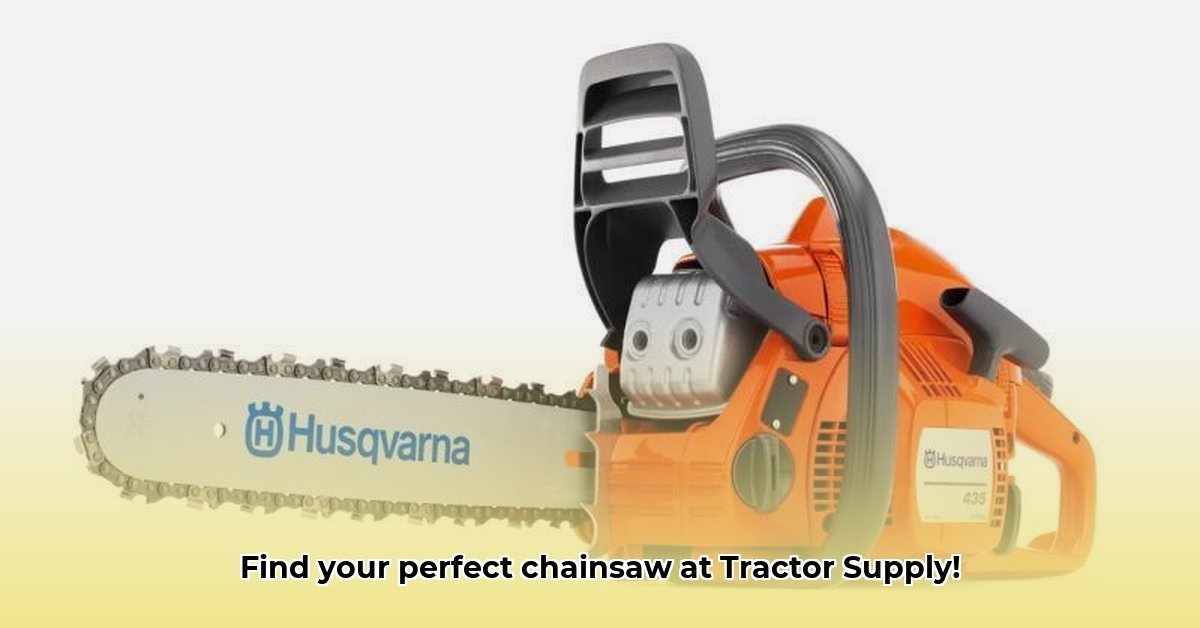
Choosing the right chainsaw can feel overwhelming, but it doesn't have to be. This guide helps you navigate the options at Tractor Supply, ensuring you find the perfect tool for your needs and skill level. We'll cover chainsaw types, selection criteria, safety precautions, maintenance tips, and even highlight some Tractor Supply offerings. Let's get started! For more information on Tractor Supply's offerings, check out their website.
Types of Chainsaws: Gas, Electric, and Cordless
Tractor Supply offers a variety of chainsaws, each with its own strengths and weaknesses. Understanding these differences is crucial for making an informed decision.
1. Gas-Powered Chainsaws: These are the workhorses of the chainsaw world, offering superior power for demanding tasks like felling large trees or cutting substantial logs. They provide longer runtimes than electric or cordless alternatives. However, they are louder, require more maintenance (oil changes, spark plug checks), and produce exhaust fumes. Gas chainsaws are best for large-scale or heavy-duty projects. Are you tackling a large-scale project that demands significant power and extended runtime?
2. Electric Chainsaws: Electric chainsaws are a quieter, more environmentally friendly option, ideal for smaller jobs like trimming branches or cutting firewood. They are lightweight and easier to handle, perfect for beginners. The significant drawback is their reliance on a power cord, limiting mobility. Do you need a lightweight, easy-to-handle saw for smaller projects and prefer quieter operation?
3. Cordless Chainsaws: Cordless chainsaws offer a balance between power and portability. They're quieter than gas-powered versions and more convenient than corded electric models, suitable for medium-sized projects. However, battery life is a limiting factor; you may need extra batteries for longer jobs. Cordless saws often command a higher upfront cost. Is maneuverability and the absence of a power cord a priority for your average project length?
Selecting the Right Chainsaw: A Step-by-Step Guide
Choosing the right chainsaw involves considering several key factors:
Power Needs (Engine Size/CC): Larger projects require more powerful saws (higher cc rating). Smaller jobs, such as yard work, can be handled by less powerful models. Consider the typical size of the wood you’ll be cutting.
Bar Length: The bar length determines the depth of cut. Longer bars are better for larger logs, while shorter bars offer improved maneuverability for smaller jobs. A longer bar means more power is needed.
Budget: Chainsaws vary significantly in price. Consider the total cost, including initial purchase, maintenance and potential repairs over the life of the saw. A higher price often reflects greater quality and longevity.
Experience Level: Beginners should start with smaller, less powerful saws with shorter bar lengths for better control and safety. Gradually upgrade as skills improve.
Intended Use: What kind of jobs will you primarily be using the saw for? This directly impacts engine size, bar length, and even the type of saw – gas, electric, or cordless.
Safety First: Essential Precautions for Chainsaw Use
Safety is paramount when operating a chainsaw. Never compromise on safety gear or procedures.
Personal Protective Equipment (PPE): Always wear safety glasses or a face shield, hearing protection, sturdy work gloves, closed-toe boots, and chainsaw chaps (leg protection). This is non-negotiable.
Pre-Use Inspection: Before every use, inspect the chain for sharpness and proper tension; check the bar lubrication and ensure all components are secure and functional.
Controlled Cuts: Never force a cut. Maintain a firm grip and use smooth, controlled movements. Avoid reaching over the running chain.
Kickback Awareness: Understand the mechanics of kickback and learn how to minimize the risk. This involves proper cutting techniques and maintaining control.
Work Area Preparation: Clear the work area of debris and obstacles. Be aware of your surroundings and other individuals nearby, ensuring a safe working distance.
Maintaining Your Chainsaw: Extending Its Life and Safety
Regular maintenance is vital for optimal performance and continued safe operation.
Chain Sharpening: Sharpen your chain regularly to maintain efficient cutting and reduce the risk of kickback. A dull chain significantly increases the risk of injury.
Bar and Chain Lubrication: Apply bar oil regularly to prevent excessive wear and tear and ensure smooth chain movement.
Air Filter Cleaning: Clean or replace the air filter regularly to maintain optimal engine performance and prevent damage.
Storage: Store your chainsaw in a dry, secure location when not in use to prevent rust and damage.
Tractor Supply Chainsaw Selection
Tractor Supply offers various chainsaw brands and models. Research their offerings online or consult with store staff for personalized advice. Compare features, warranties, and prices to make the best choice for your specific needs.
Key Takeaways:
- Choosing the perfect chainsaw depends on the project scale, budget, and user experience.
- Safety gear is non-negotiable and proper maintenance is crucial for both safety and tool longevity.
- Tractor Supply provides a range of options to suit varying needs, budgets, and skill levels. Utilize their resources to make an informed decision.
Remember to select a chainsaw that perfectly aligns with your needs and skill level, and always prioritize safety!